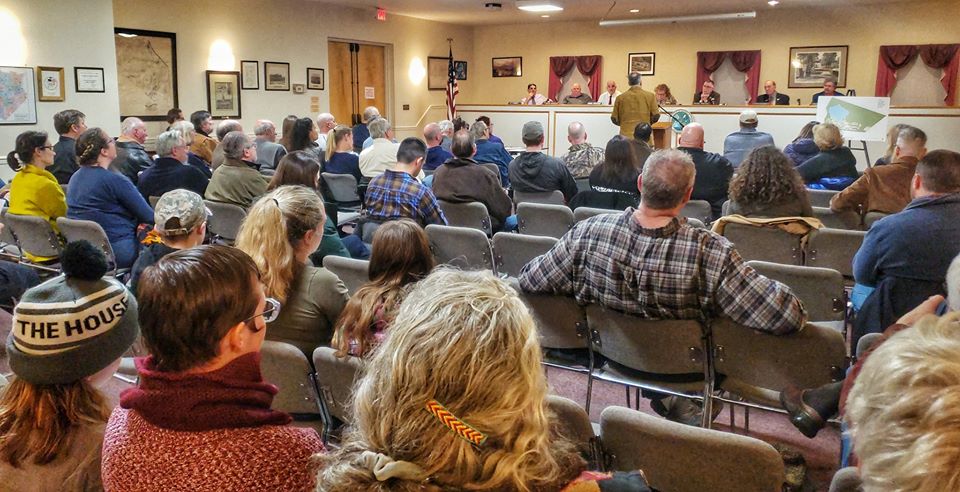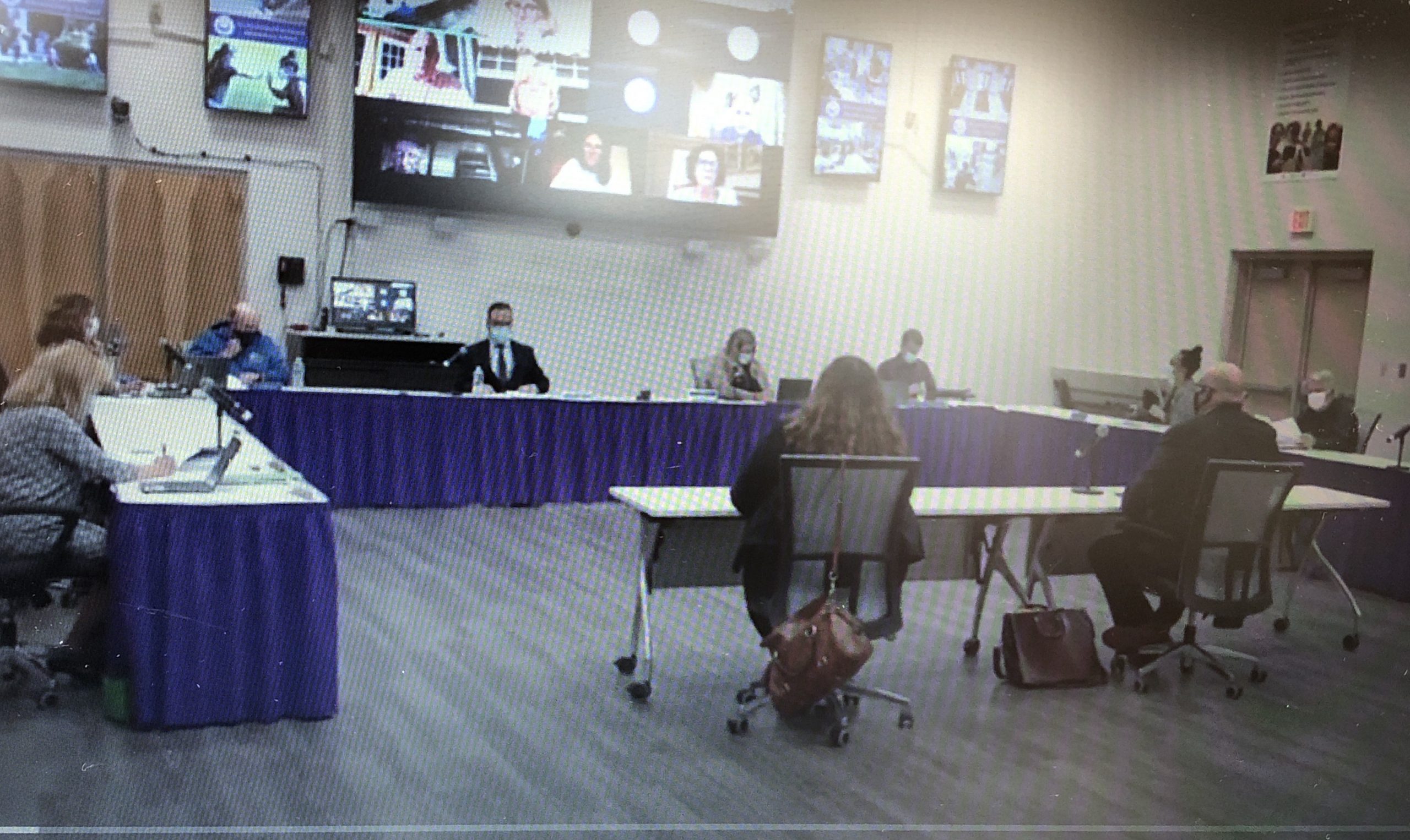Story by Katie Bisaro
A standing room only crowd filled the Town of Warwick Planning Board meeting on Wed., Dec. 18, for a public scoping session to speak about the proposed development of the property on the corner of West St. and County Rte. 1, commonly known as the “Pulpit Rock” property.
Pulpit Rock, so named for the 20-foot glacial monolith that looms over the landscape of the property and where, according to Town of Warwick Historian Dr. Richard Hull, European settlers and their pastors “reputedly held summer outdoor religious services in the 18th and early 19th centuries.”
The nine-acre Pulpit Rock property, owned by Stephen Kitar of NADA LLC, is now the focus of a proposed hotel establishment as the owners have begun the process of seeking approvals for their project.
Upon opening the discussion, Town of Warwick Planning Board Chairman Benjamin Astorino clarified the purpose of the meeting and the Planning Board’s role and purpose. He commented that this meeting was just the beginning of a long process and that no applicant documents have been submitted as yet.
Astorino pointed out that there will be numerous public hearings on this matter as the process continues. He emphasized that the Planning Board’s role is to follow the zoning code.
“As a Planning Board, we focus on the code. We do not write the code, we do not change the code, we follow the code. We make sure the applicant follows the code,” Astorino stated before commentary from the public began.
A Minimum of Three Public Hearings Will be Held
Ted Fink, Town of Warwick Planner, outlined the process involved in seeking approval for a project from the Planning Board. He noted there will be a minimum of three public hearings held at a later time.
Fink explained that the Planning Board’s activities are dictated and regulated by the State Environmental Quality Review Act (SEQRA) and that, in accordance with state law, the first step in the process is an environmental review and the preparation of a Draft Environmental Impact Statement (DEIS) – a comprehensive document that will analyze different areas of the environment that could potentially be affected by the proposed project. The DEIS evaluates potential impacts on the environment as well as the mitigation measures available to reduce or avoid impacts in such areas as water, wetlands, wildlife, traffic, community character and other issues that may be of interest to the public.
The precursor to the DEIS is the scoping document. At the Dec. 18 Planning Board meeting the public was invited to make their views and concerns known regarding the Pulpit Rock project, all of which will be included in the Draft Scoping Document, as well as any suggestions for mitigating those concerns.
Written Comments Accepted Until Jan. 2
The Planning Board will take the draft scoping document, along with comments from the public, both verbal and written, and provide that to the applicant to be used to create the DEIS. Written comments will be accepted until 4 p.m. on Thurs., Jan 2.
Pulpit Rock Project
Karen Emmerich, of Lehman & Getz Engineering, outlined the proposed project on behalf of the applicant.
The nine-acre parcel on West St. is in the Suburban-Low Density (SL) zone. The proposed hotel will consist of a main 7,853 square foot building with hotel rooms, lobby and breakfast area. Additionally, there are plans for six 2,236 square foot eight-unit “cottages” that will be located along West St., a pool, parking and storm water management.
Pulpit Rock is to Remain ‘Intact & Not Moved or Destroyed in any Way’
The proposed hotel project will be served by a well and a small sewage treatment plant. The plans include a 200-foot buffer from residential property as well as a 100-foot buffer from the Wawayanda Creek, both as per code. The “pulpit rock” is to remain “intact and not moved or destroyed in any way.”
Astorino pointed out that the renderings that were displayed at the meeting had not been submitted to, nor reviewed by, the Planning Board as yet.
Public Commentary
More than 20 residents spoke during the public commentary portion of the meeting. The speakers expressed concerns about a variety of issues regarding the proposed project including historical significance, run-off into the Wawayanda Creek and other water-related issues, traffic safety and congestion, noise and light pollution, the proximity to schools, potential damage to the Pulpit Rock itself, quality of life and property values.
Historical Significance
Dr. Richard Hull stressed the historical and archeological significance of the Pulpit Rock site with respect to its importance as a prehistoric Native American land, in particular the Lenape people. He encouraged an independent, thorough and comprehensive archeological survey of the property and believes that the land should be preserved.
“I believe that in the final analysis ours and future generations of people will be judged not only by what we have created but by what we have refused to destroy. This unique site provides us with a rare opportunity to understand, to celebrate, and to honor our community’s prehistoric past in order for us to better prepare for its future,” Dr. Hull stated at the end of his comments.
Water, Traffic & Safety Concerns
Several speakers expressed their concerns about water issues including run-off into the Wawayanda Creek, which runs through the property, as well as the effect the development may have on the ecosystem and the ground water aquifer.
Traffic – both congestion and safety – was another concern brought up by several residents. It was pointed out that West St. is already a busy thoroughfare, especially during school hours as it is within close proximity to three schools (Warwick Valley High School, Middle School and St. Stephen-St. Edward School) and serves as the bus routes for those schools as well as the others in the district.
Moreover, there are no sidewalks along West St. between Pond Hill Rd. in the Village of Warwick and County Rte. 1. This has been a safety concern for many years as students walk to and from the Village along West St.
Other safety issues that were brought up included the possibility of illegal and dangerous activity that can sometimes be present in hotels such as the illegal dealing of drugs, sexual predators, and sex trafficking. Many felt that the proposed project’s proximity to schools added to this concern.
Does the Community Need a Hotel?
Nancy Driscoll, whose Eagle’s Watch home overlooks the Pulpit Rock property commented that she ran a local inn with her husband for three years. She pointed out that the busy season is during the fall but otherwise was more sporadic. She wondered if there was a need for 100-plus hotel rooms (the main building combined with the cottages) on a regular basis.
Mary Bono, of Division St., suggested a very thorough investigation and survey of the available inns, Bed & Breakfasts, AirBnB’s etc. to gain an understanding of the need for a hotel in this community.
Another resident questioned the proposed development’s fate should the business fail at some point in the future, what would become the property and who could potentially purchase it for other uses.
Property Not Conducive to Development
Michael Pennings, who has lived on West St. across the street from the proposed project since 1953, opened his remarks with: “There’s got to be a better place in Warwick for this project.”
He pointed out that his family previously owned and farmed the property for about 70 years. He noted that it was not conducive to crops as the “drainage was bad” and there is a rock ledge along the knoll where the pulpit rock feature is located.
According to Pennings, in order to level the property and prepare it for development there will be a need for large [jack]hammers or blasting equipment which will not be conducive to keeping the rock “standing.”
Quality of Life, Special Use Permit Concerns
Tara Lambert, of West St. near the Pulpit Rock property, pointed out that the six “cottages” were slated to be larger than her 1,800 sq. ft. home. She is concerned about the noise, light and traffic that will increase as a result of this proposed development affecting her family’s ability to enjoy their home as well as the effect it may have on her property values. She asked for clarification of the definitions of zoning versus special use permits.
Fink explained that a special use permit applies to “certain uses above and beyond the residential uses you might associate with a zoning district.” They are uses that the zoning has taken into consideration regarding “potential objectionable characteristics” and as a result there are “certain special conditions” that apply to anything that would be proposed within the residential zoning district.
Fink continued that the Planning Board has to review not only the environmental impacts and mitigation measures but also the special permit conditions of a proposed project to ensure that the applicant has satisfied all the necessary conditions for approval.
“It goes above and beyond simply the site plan requirement…the special permit also looks at things like noise, excessive traffic, those kinds of characteristics that may make it incompatible,” Fink stated.
Suggestions for PDR Purchase
Several residents spoke in favor of having the Town of Warwick use its Purchase of Development Rights funds, monies that are collected through the Community Preservation Fund, to purchase the Pulpit Rock land and preserve it for the community adding to the “ring” of properties that serve as gateways into the Village. That situation is not under the Planning Board’s purview.
Lifetime Warwick resident, John Stage, mentioned all the properties that are part of the PDR program surrounding the Village and asked the Planning Board to consider the fact that as school busses pass by it [Pulpit Rock] is a lasting reminder to students of a connection to the past.
“There’s only one Pulpit Rock, only one real connection to the people that lived here before us…The best we can do is to be mindful of our history, of our long-term history,” Stage said.
Comments Will Be Compiled, Available For Review
Chairman Astorino thanked all who attended the scoping session for their thoughtful and respectful commentary. He reiterated that the Planning Board “cannot change the zoning code as it is written” and every application brought before it is considered with professionalism by the entire board.
Everything that was said during this meeting, along with the written comments, will be compiled into the scoping document and will be public record and available for review. All information on matters pertaining to the Planning Board are available on the Town of Warwick website, www.townofwarwick.org through the Planning Board link.
Planning Board Meetings
The Town of Warwick Planning Board typically meets the first and third Wednesdays of the month at Warwick Town Hall, 132 Kings Hwy., in Warwick. A calendar of meetings is available on the Town of Warwick website.








